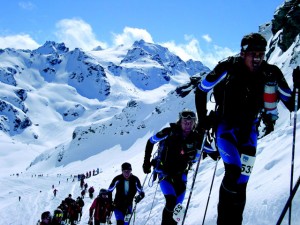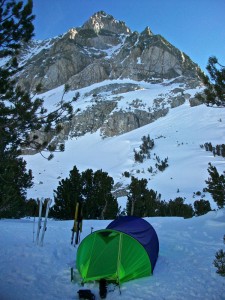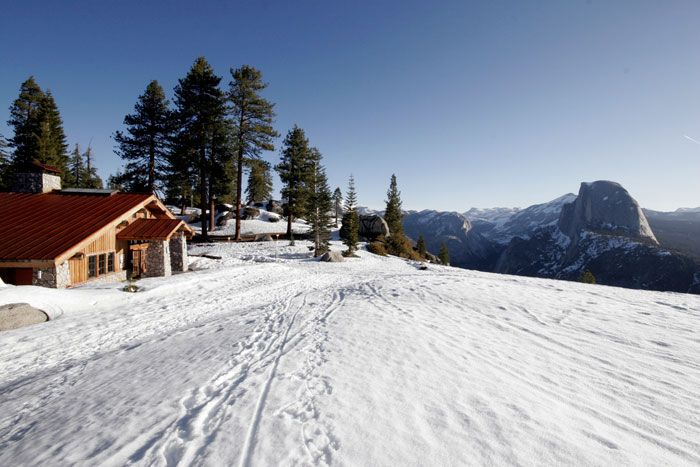- Yosemite E-Biking - 01/12/2023
- The Yosemite Climbing Association - 09/01/2022
- Ryan Sheridan & Priscilla Mewborne - 05/17/2022
Thoughts on preparedness and losing a friend
By Chris Van Leuven
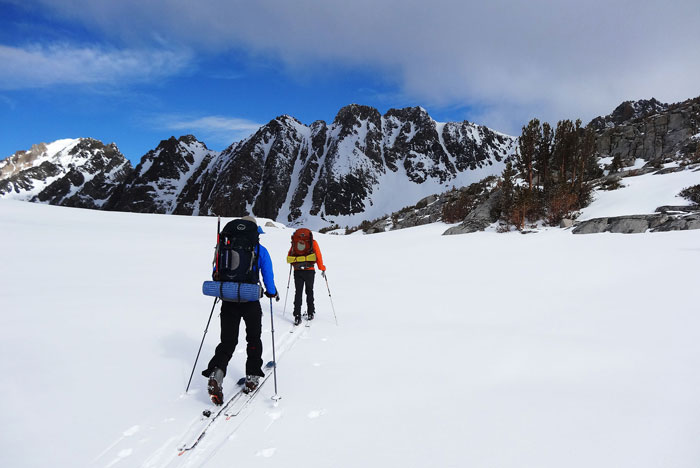
Classic beautiful Sierra ski touring from Rock Creek to Mammoth (Ryan Huetter).
By now most readers have heard of the early October slide on Montana’s Imp Peak that claimed the life of Inge Perkins (23) and, later from suicide, Hayden Kennedy (27). The couple were swept by a slab avalanche 300 feet long by 150 wide with a crown of one to two feet that resulted in a full burial for Perkins and a partial one for Kennedy.
The following day, after Kennedy was found unresponsive in his Bozeman home, which he shared with Perkins, personnel from the Gallatin National Forest Avalanche Center were able to locate Perkins under three feet of snow. They found her from written directions left by Kennedy showing where he last saw her on the 11,202-foot peak.
While writing this I’m looking at a picture I brought home from Kennedy’s memorial in Carbondale, Colorado. In the shot, he’s smiling and dressed in a blue micro-puff jacket. The picture is tied to a pine tree stem wrapped in sage. I never knew Perkins, but after reading countless articles on her and hearing about her at the memorial, I know they brought immense joy to one another’s lives.
The slope they were skinning up, where the avalanche took place at 10,000 feet, was “38-45 degrees steep with a north-northeast aspect,” the Gallatin Avalanche Center reported. The area received a foot of fresh snow a week before, which sat on top of three or four feet of snow that fell on the mountain in mid-September.
When Perkins was located, it was discovered that her beacon was stashed in her pack and turned off. Would the two still be alive if they were properly using their equipment? We’ll never know.
Perkins could have died from trauma, which would have made the point about her beacon being off moot. And though proper use of avalanche equipment, including beacons, probes, shovels and air bags, can help save lives, there’s no guarantee.
Thinking of their moments in the fatal slide reminds me of the time I was in a car that flipped over on the highway after the driver fell asleep going about 60 mph. We were both wearing our seatbelts, but as hard concrete smashed into fragile windshield glass, again and again, my head nearly impacting the ground on each flip, I knew it was just a matter of chance if we made it or not. Surviving an avalanche can be viewed the same way, except the victims in a slide often find themselves helpless in a river of fast-moving, heavy debris. Disorientation can occur; people get slammed into trees, fall off cliffs, and knocked with heavy blocks of snow or hit rocks. I can only imagine the fear they experienced, followed by Kennedy’s panic after he dug himself out and could not locate his partner.
As friends and family of the deceased move on with their lives, carrying the pain and loss of their loved ones like a river of pain flowing into an ocean — as Kennedy’s father said at the service — now may be the time to be aware of best practices for traveling in avalanche country.
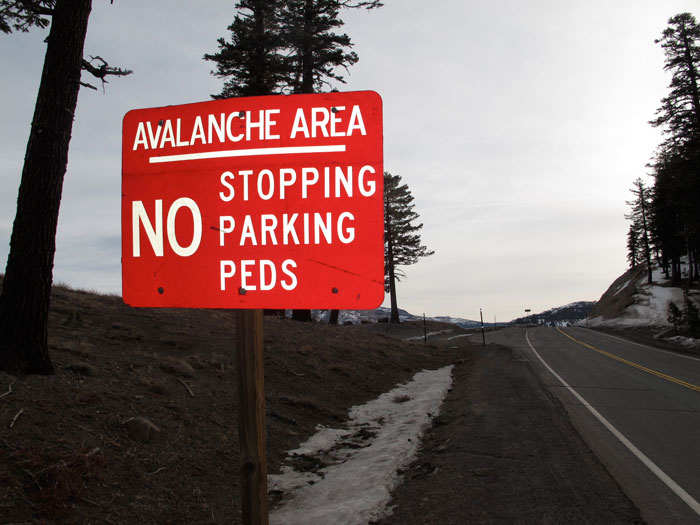
Backcountry travelers can do exactly what motorist are advised — don’t dally in the danger zones.
The Ski Industry Association estimates that today there are more than six million backcountry skiers worldwide, ten times more users in recent years, with a “death rate at less than 0.5 per 100,000,” or 27 per year, according to Mountain Culture Group. This number also includes snowmobilers and snowshoe hikers. Of note, people trigger nine out of ten avalanches.
“Avalanches are very violent events,” Bruce Tremper of the Utah Avalanche Center says in a video. “One out of four people are killed by the trauma of hitting trees and rocks along the way down. Then the avalanche debris instantly sets up like concrete. You can’t just pop out of there. Somebody else has to get you out of the snow.”
Unlike a car wreck, which is caused by many variables that are out of your control, getting caught in an avalanche has much more to do with proper decision-making by people in a group. “The only time we should even consider getting into steep terrain is when we have safe avalanche conditions,” continues Tremper.
This means checking local avalanche reports — it’s crucial to do your homework and research legit resources for the areas you are entering.
During and immediately after storms avalanche risk is the greatest. However, weeks or months after a storm the snowpack structure may still be unstable. Slopes in California and the Pacific Northwest are different than those in the Midwest. The maritime snowfall that shrouds the mountains in white in the west often causes avalanches in the first 24 to 48 hours, with much of the immediate dangers subsiding after that period. The more time that passes after a storm, the safer the slope becomes, but avalanches can and do still occur.
Though some people view heading out into avalanche country as playing roulette with a loaded gun, others know which slopes are safest, and where various types of avalanches are most likely to occur.

Very large D4 avalanche on Mount McGee near Mammoth (SP Parker).
Below are five ways to prepare for entering avalanche country, whether you’re a snowmobiler, skier, snowshoe hiker, ice climber or general recreationalist.
1 Attend at least one course through AIARE (American Institute for Avalanche Research and Education) or a similar school, and take refreshers. The Sierra Avalanche Center lists transceiver workshops, avalanche seminars, and refreshers at locations throughout California, including Bear Valley, the Bay Area and Donner Summit. Avalanche.org offers online courses. Other resources include the Eastern Sierra Avalanche Center and Mount Shasta Avalanche Center.
2 Learn the basics of terrain and how to manage it, being pro-active in avoidance. As renowned avalanche specialist Karl Klassen points out, “The snowpack is a capricious and erratic acquaintance who you never get to know very well. The terrain is a steady and predictable friend that you can always depend on.”
3 Ensure your transceiver has fresh batteries and that it’s technologically up-to-date, and know where to keep it on your body (i.e., away from cell phones).
4 Use avalanche safety equipment including beacons, probes, shovels, radios, and airbags. “Your chances of surviving an avalanche are doubled if you’re wearing an airbag,” says Bruce Edgerly, co-founder of Backcountry Access. Set up mock burials, and time yourself in searches. And rehearse.
5 Visit KBYG.org, which stands for Know Before You Go. The website contains a 15-minute video which shows someone getting buried — complete with a terrifying scream — before getting dug out. “If you live close to snow-covered mountains, you need to know about avalanches,” says the narrator. “It just goes with the territory.”

Doing a compression test to help assess snow stability (SP Parker).

An inclinometer helps to judge slope angles and to gauge how far avalanches might run (SP Parker).
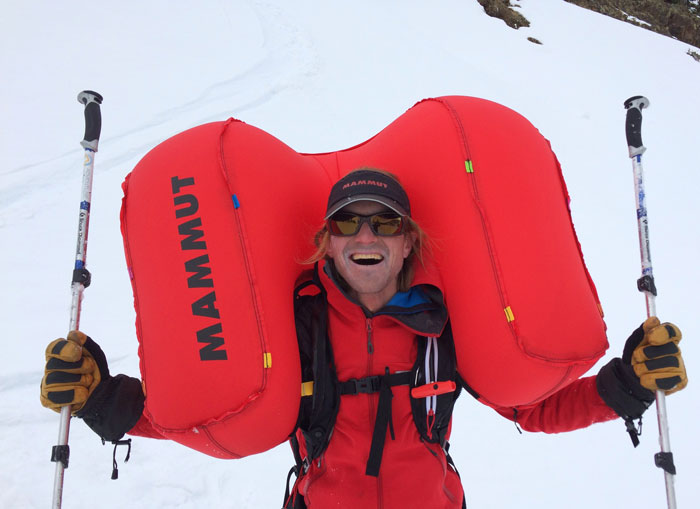
Airbags are the latest in avalanche survival and save lives through buoyancy and head protection (Ryan Huetter).

Surface hoar crystals are lovely to look at but a major problem once buried (SP Parker).



